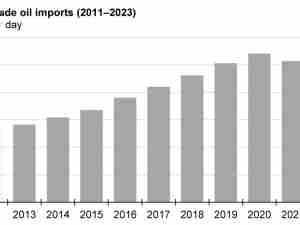Oil fell in a day of wild price swings as investors weighed supply-and-demand fundamentals against Saudi Arabia’s global price hike.
Futures in New York dropped 1.8% Thursday. State-run Saudi Aramco raised prices on almost all grades for June, sending futures surging. But the market remains glutted after the kingdom exported record amounts of crude in April. The level of excess global supply averaged 21.3 million barrels a day last month, according to Standard Chartered Plc analysts.
“With the prices going up the way they have the last couple of days, I think they are going to pause around here,” said Phil Streible, chief market strategist for Blue Line Futures LLC.
The OPEC+ coalition that includes Russia started implementing output cuts of 9.7 million barrels a day this month. While the Saudi pricing brought brief relief to the market, a robust demand increase is what’s needed to sustain higher prices, according to Will Rhind, chief executive officer at GraniteShares Advisors Llc.
“It has to be demand driven at the end of the day,” Rhind said. “Whether it’s higher prices or a cut in supply, ultimately that has to be met by real demand.”
There are signs that oil demand is recovering, and may even exceed supply by as early as the start of June, according to Goldman Sachs Head of Commodities Research Jeff Currie. Gasoline demand is gaining steam in the U.S. with the premium for fuel over diesel at its highest since 2017. On top of that, weekly gasoline supplied, an indicator of consumption, rose by 804,000 barrels a day last week, the biggest bump since June 2018, according the U.S. Energy Information Administration.
View the latest market-moving news and analytics surrounding volatile crude prices from Bloomberg.
Genscape Inc. also reported on Thursday that stockpiles in Cushing, Oklahoma, fell more than 350,000 barrels since Friday, according to market participants. It will be the first contraction since late February if the U.S. government reports a decline for the full week on Wednesday.
However, Rhind cautioned that, if a potential second wave of the virus returns people back to their homes and off the roads, demand could swiftly reverse.
“That’s a big question mark on the oil demand,” he said.







_A_-_28de80_-_38f408a0a1c601cdbf9fe70c9d30a28084a5da3d_lqip.jpg)

